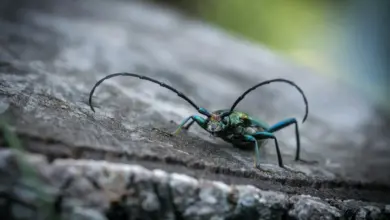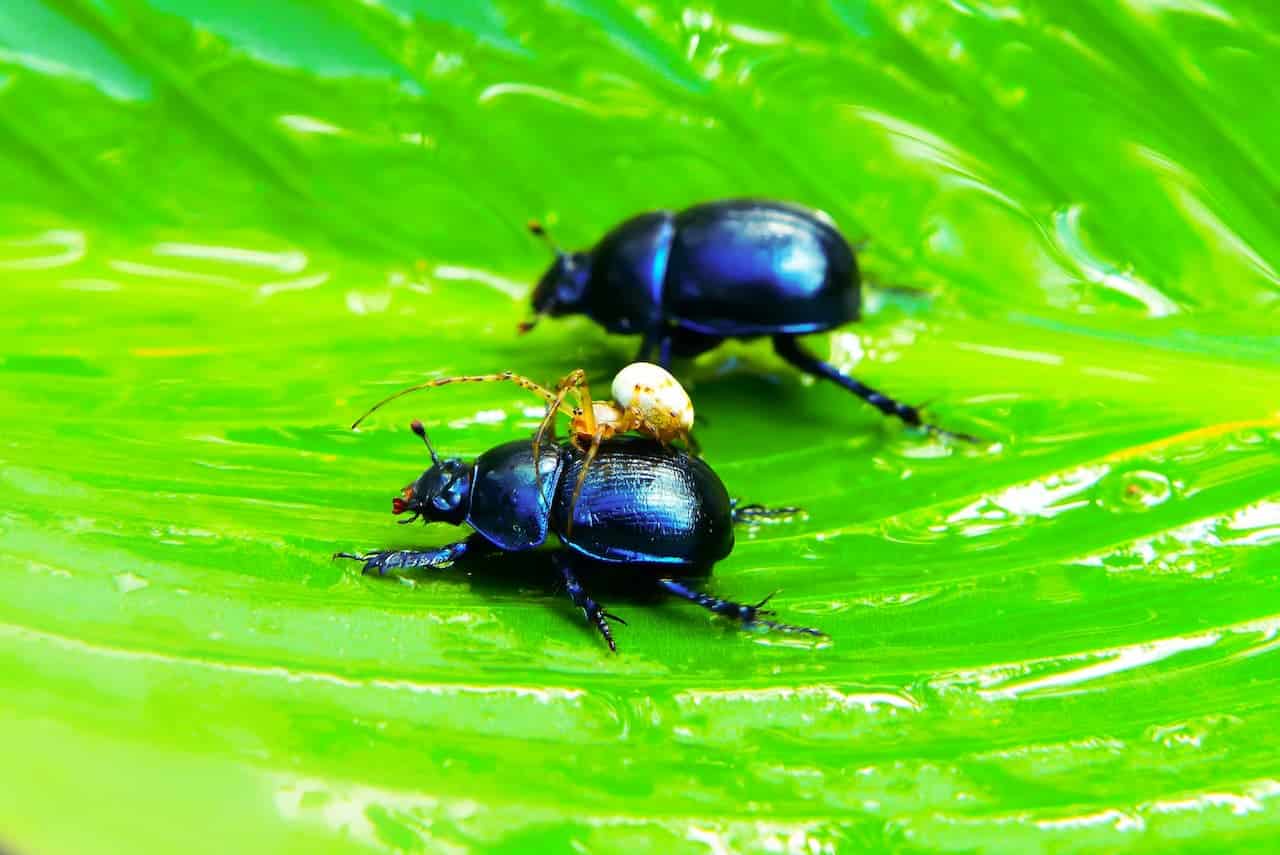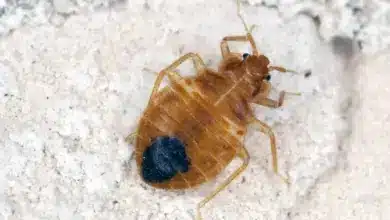The African Goliath Beetle – Goliathus Giganteus
The African Goliath beetle (Goliathus giganteus) is a large species of insect that is found in the tropical forests of Africa. It is part of the family Scarabaeidae and is known for its impressive size and striking appearance.
Some key facts about the Goliath beetle include that it can reach sizes of up to 110 mm, making it one of the largest beetle species in the world. It exhibits sexual dimorphism where the males are larger than females with long curved horns used for battling other males.
The larvae feed on decaying wood, while the adults eat tree sap and fruit. Their lifespan is around 3-6 months from larva to adult. They are mainly active at night and hide in trees during the day.
The Goliath beetle plays important ecological roles, including nutrient recycling, seed dispersal, and pest control. The beetle has become a popular pet among insect enthusiasts due to its size and unique look.
However, care should be taken when keeping them in captivity. This article will provide an extensive overview of the African Goliath beetle, including its anatomy, habitat, diet, life cycle, conservation status, and more.
Anatomy and Appearance
The most distinguishing feature of the Goliath beetle is its large size, from which it gets its name – ‘Goliath.’
Males can reach lengths of up to 11 cm (4.3 inches), including the elongated horns protruding from their heads. The overall shape is elongated and oval. The elytra or wing covers are dark blackish-brown in color with white bands along the sides.
The underside of the body has a coppery or golden sheen. The legs are thick and robust, adapted for clinging onto tree trunks. Their most notable anatomical feature is the horns present in the males.
The male Goliath beetle has a Y-shaped horn formation arising from the front of the head. The center horn can grow exceptionally long, sometimes even longer than the rest of the body. The female Goliath beetles do not possess any horns.
Other key anatomical features include powerful mandibles used for chewing food, compound eyes providing all-around vision, three pairs of jointed legs with claws for grasping, spiracles along the sides of the body for respiration, and a heavily sclerotized and armored exoskeleton.
Some distinguishing traits between males and females include that males have a larger size, up to 110 mm in length, long Y-shaped horns on the head, a more robust, square-shaped body, and darker coloration, especially on the horns.
Females have a smaller size, up to 80 mm in length, no horns, a rounder, oval body shape, and lighter brown coloration.
Habitat and Distribution
Goliath beetles are native to the tropical forests of Africa. They range across equatorial Africa from Ghana to Ethiopia and down to Botswana and South Africa.
Specifically, they inhabit lowland and mountainous tropical forests where there is plenty of vegetation and high humidity. Prime areas include rainforests and woodlands.
Some key habitat features preferred by Goliath beetles include dense stands of trees that provide food sources and shelter and act as mating sites. The presence of decaying logs on the forest floor is preferred as the larvae feed on them.
Canopy trees that produce sap flows and rotting fruit are also ideal. Goliath beetles prefer a shady, humid environment with temperatures around 20-28°C and areas with high annual rainfall over 1000 mm.
Goliath beetles play an important role in these tropical forest ecosystems. The larvae assist in nutrient recycling by breaking down decaying wood. The adults transport pollen, seeds, and fungal spores on their bodies, facilitating the propagation of plants.
Within their forest habitat, Goliath beetles tend to be solitary and territorial. The males will aggressively defend tree trunks, fruiting bodies, and other prime sites which they use to attract mates.
Females occupy similar sites for feeding. Both the adult beetles and larvae lead cryptic lifestyles hidden in the forests.
Diet and Foraging Behavior
The diet and foraging behavior of Goliath beetles varies between the larval and adult stages:
Larval Diet
Goliath beetle larvae feed on decaying wood from dead trees. Their preferred food is moist, decayed wood from fallen logs, stumps, and rotting tree trunks.
The wood needs to be partially decomposed or mulched by fungi to be palatable for the larvae. By breaking down the wood, the larvae play an important recycling role in the ecosystem.
Larvae have strong mandibles adapted for grinding and digesting the tough, fibrous wood material. The decaying wood provides nutrients as well as a safe, moist environment for the larvae to develop. The larvae maintain tunnels and galleries within the logs while feeding.
Adult Diet
Adult Goliath beetles have a varied diet. Some food sources include:
Tree sap: Primarily feed on the sap flows from wounds or scars on the bark of certain trees. Favorite sap trees include wild fig trees.
Fruits: Feed on overripe, fermented fruit that has fallen to the ground. Bananas, mangoes, and guavas are highly attractive.
Plant nectar: Extract nectar from flowers of montane tree species. Supplementary food source.
Soft plant parts: Chew on soft leaves, bark, plant shoots, and stems.
The adult’s strong mandibles allow them to bite directly through the tough outer layers of bark and fruit to access the soft, nutritious interior. Their diet provides important energy for the activities of reproduction and territorial defense.
Adults employ a ‘sit-and-wait’ strategy while foraging. They remain stationary on a tree trunk or fallen log, waiting for food to become available. When they detect ripe fruit or sap flows, they rapidly dig into the food source. If disturbed, they retreat back into the forests.
Life Cycle and Reproduction
Goliath beetles undergo complete metamorphosis with four life stages – egg, larva, pupa, and adult. Their lifecycle takes around 3 – 6 months.
Eggs
Adult female beetles lay about 20-50 white, spherical eggs in decaying logs. The eggs hatch within 3-4 weeks.
Larva
Larvae emerge from eggs and immediately burrow into decaying wood to feed. The larvae develop through 3 instars over 4-6 months, shedding their exoskeleton between each stage.
Mature larvae reach 100mm in length and have white, C-shaped, grub-like bodies with orange heads and strong mandibles. Pupation occurs in specially constructed chambers within the feeding galleries in logs.
Pupae
The pupal stage lasts around 1 month. Inside the pupal case, the larva undergoes complete metamorphosis into the adult beetle form.
Adult
Adult beetles emerge from pupae in midsummer, June-August. Reproductive maturity is reached in 2-4 weeks after emergence. Males locate mates by patrolling suitable trees and defending territory.
Mating occurs at night on tree trunks where males grasp females with forelegs to mate. Females lay eggs soon after mating and then die shortly afterward. The adult lifespan is only 3-6 months. Adults do not feed during the short mating and egg-laying period.
Behavior and Communication
Goliath beetles display some fascinating behaviors and means of communication.
Territoriality and Aggression
Adult males are highly aggressive and territorial, defending tree trunks and fruiting bodies. Male-male battles occur by grasping opponents with spiny forelegs and attempting to dislodge them from trees.
The long horns are used as weapons in these fights, and the beetle with larger horns typically wins. Losers get tossed from trees and often lose mating opportunities.
Pheromone communication
Pheromone communication also plays an important role in mating. Males produce aggregation pheromones that attract both males and females to suitable habitats. Females also emit sex pheromones when receptive to mating, which helps coordinate reproduction.
Stridulation
Goliath beetles can produce chirping sounds via stridulation by rubbing body parts together. Scrapping of legs against the pronotum produces defensive squeaking sounds, while males also stridulate to attract mates by rubbing legs against the elytra.
Antennae Sensitivity
Their antennae are covered in sensitive receptors for detecting smells, touches, tastes, and vibrations, which allow beetles to hone in on food sources, mates, and perceive habitat conditions.
Nocturnal Activity
Goliath beetles are mainly active at night and hide in trees during the day, which avoids overheating, drying out, and avoids some predators. Night activity also coincides with the availability of food flows like sap.
Conservation Status and Threats
The African Goliath beetle is currently classified as Least Concern by the IUCN Red List. However, some concerning population declines have been observed across its native habitat, indicating the need for continued monitoring.
Habitat loss from deforestation
Habitat loss from deforestation, including logging, land clearing, and fragmentation of tropical forests, is the biggest threat to Goliath beetle populations. Most intact forest habitats remain unprotected.
Overcollection
Overcollection of numerous beetles from the wild for the pet trade, scientific collections, etc., may also impact local populations.
Invasive species
Invasive species like crazy ants can disturb the forest ecosystem and compete with larvae, while transported parasites of larvae are another concern.
Climate change
Climate change and the increased droughts and temperatures in the tropics could affect forest composition and health, with drying conditions in particular impacting larvae in logs.
Pesticide use
Pesticide runoff into watersheds and aerial spraying can also impact many non-target insects like beetles.
To protect the iconic Goliath beetles, further research is needed to determine population sizes and trends.
Conservation priorities include designating protected wildlife and forest reserves, regulating harvest/trade, controlling invasive species, and monitoring climate impacts. Sustainable ecotourism focused on the beetles may also aid conservation efforts.
Keeping Goliath Beetles as Pets
The impressive size and physique of Goliath beetles have made them popular display pets. However, they do require specialized care in captivity.
Acquisition
In many areas, it is illegal to collect Goliath beetles from the wild, so captive-bred beetles need to be purchased from specialized insect breeders.
Housing
A large terrarium or vivarium needs – at least 40 x 40 x 60 cm for one beetle. The terrarium needs a ventilated lid, substrate, plants, hides, and wood. Temperatures should be maintained around 25°C. Males should be kept separate to prevent fighting injuries.
Feeding
Larvae require decomposing wood from logs or driftwood. They also eat high-protein bird food. Adults eat mashed fruit like bananas and melon, which can be provided on wood blocks.
Small amounts of honey and pollen can also be fed. Fresh food needs to be supplied daily, and access to water is provided via misted leaves.
Handling
Goliath beetles can be handled but need to be carefully restrained. They may pinch with mandibles when distressed, so the entire body must be supported and the abdomen not squeezed.
Avoid grasping the elytra. Hands should always be washed before and after handling.
Enrichment
For enrichment, decaying wood blocks, logs, branches, and bark should be provided for a naturalistic environment. Supervised time for climbing on hands and exploring outside the enclosure is also beneficial.
Life Span
Larvae can be raised through pupation to adult in 6-12 months with proper care. However, the adult lifespan is just 3-6 months on average, with males potentially living a few months longer than females. Providing an excellent diet and habitat can maximize longevity in captivity.
The Goliath beetle requires an experienced keeper who can provide for its specialized habitat, food, handling, and life cycle needs. With proper care, though, they make truly engaging pets.
Frequently Asked Questions
How big do Goliath beetles grow?
Goliath beetles are one of the largest beetle species in the world. Males can reach lengths up to 11 cm (4.3 inches), including their long forward-projecting horns. Females reach slightly smaller sizes, around 8 cm.
Are Goliath beetles dangerous?
Goliath beetles are not considered dangerous to humans. They do have strong pincers for biting but rarely bite unless severely provoked. The pincers can produce a painful pinch but cannot break human skin.
Where are Goliath beetles found in Africa?
Goliath beetles are found in equatorial Africa from Ghana to Ethiopia and south to Botswana and South Africa. They inhabit dense tropical and subtropical forests across these regions. The prime habitat is lowland rainforests.
Why are Goliath beetles important for the ecosystem?
Goliath beetles provide key ecological services. The larvae recycle nutrients by feeding on decaying wood. The adults transport pollen, seeds, and fungi as they forage, facilitating plant propagation. They also control pest populations as both larvae and adults are predators.
What is the purpose of the horns on a male Goliath beetle?
Male Goliath beetles use their horns to battle other males for access to prime habitat and mating opportunities. The male with the largest horns usually wins these fights. The horns serve as weapons and also make the beetles appear larger.
Why are Goliath beetles becoming threatened?
Habitat loss from deforestation is the biggest threat to Goliath beetles. Logging, agricultural conversion, and human settlements are encroaching on their tropical forest ecosystems. Overcollection, invasive species, and climate change also impact their populations.
How can I attract Goliath beetles to my garden?
You may be able to attract Goliath beetles by providing logs, stumps, and sources of overripe fruit. However, these beetles naturally only occur in Africa. Outside of their range, attracting them to gardens is extremely challenging and not recommended.
What conditions do you need to breed Goliath beetles in captivity?
Specialized breeders keep Goliath beetles at temperatures around 25°C and high humidity. Providing large terrariums, a suitable wood-based diet, and initiating breeding behaviors is needed for successful captive reproduction. It is complex and difficult for beginners.
Can Goliath beetle larvae eat vegetables?
Goliath beetle larvae require a natural wood-based diet. While they can ingest some supplementary vegetation, vegetables alone will not provide adequate nutrition. Larvae fed only vegetables will be malnourished and unlikely to complete their lifecycle.
Are Goliath beetles noisy?
Goliath beetles can produce chirping and squeaking noises via stridulation. Males stridulate by rubbing their legs against their elytra to attract females. All beetles stridulate in distress situations by scraping various body parts together.
Conclusion
The iconic African Goliath beetle is one of the largest beetle species on Earth, instantly recognizable for the huge size and imposing horns of the males.
These colossal insects inhabit the dense, shady rainforests of equatorial Africa, where the larvae develop within decaying logs while the adults feed on fruit and sap. At night, the beetles take to the wing, engaging in dramatic battles between males and seeking out mates.
Their lifecycle is short, lasting just months from egg to adult before dying. Though currently stable in population, the Goliath beetle faces growing threats from habitat loss and climate change across its tropical range.
Further research and conservation action are needed to preserve these beetles and their forest ecosystems in the future. For now, we can appreciate the African Goliath as one of the most spectacular examples of exaggerated male weaponry and size in the insect world.
From its anatomy to behaviors and ecology, this species provides unique insights into the evolution of sexual selection and the immense diversity of beetle life. Simply put, Goliath beetles are giants among insects, deserving of appreciation and protection.






